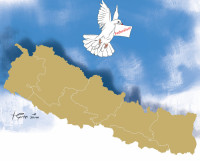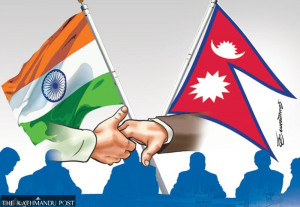Columns
Towards a knowledge driven future
Nepal needs a growth model centred on human capital development, research and innovation.
Shreesh Tripathi & Ashish Ghimire
The endorsement of the Sahid Dashrath Chand Health Sciences University (SDCHSU) Bill on May 18 by the House of Representatives is a right step towards regional equity in Sudurpaschim Province. While much of the public attention is centred on the fact that Nepal’s remote and historically marginalised regions will now host a promising public medical university and research centre, the significance of SDCHSU extends well beyond geography. It offers a promising glimpse into what could become Nepal’s long-overdue transition from a labour-exporting economy to one rooted in knowledge, innovation and self-sufficiency.
Nepal’s fragile growth model
For decades, labour outflow has served as Nepal’s economic lifeline. Remittances have lifted thousands out of poverty and fuelled domestic consumption. Yet, this growth model is becoming increasingly fragile. While the economy is slowly growing, it is not sustainable, inclusive and resilient. Nepal’s current growth path is powered by a paradox: It exports labour and imports consumption, placing limited emphasis on building domestic productivity and institutional capacity.
Worse, Nepal is squandering its demographic dividend—a unique opportunity for economic growth powered by its large, young workforce. With inadequate local opportunities, Nepal’s talent pool is either underutilised or leaving the country. This results in a dual loss of human potential and innovation capacity.
What Nepal needs now is a conscious pivot to what economists term the knowledge economy—a growth model centred on human capital development, research and innovation and the strategic use of technology. A transition to this knowledge economy is not limited to advanced nations. Countries like Rwanda, Finland and India have shown that with the right institutions and investments, even nations with limited resources can turn education and innovation into engines of economic transformation.
What is knowledge economy?
In theory, the knowledge economy prioritises data-driven decision making and the use of human capital to grow nations’ economies. Rapid advances in information and communication technologies have dramatically reduced the cost of computing and connectivity, increased affordability, and made the creation and transfer of data easier. Technology has eased the usage of knowledge, data and technology as a driving force for growth.
However, a recent World Bank report suggests that the successful operationalisation of the knowledge economy requires more than just technology. Transitioning into a knowledge economy is possible only when an institutional regime with good economic policy allows effective resource utilisation for creating, disseminating and using existing knowledge. This must also be supplemented by skilled workers who constantly adapt and upskill themselves in knowledge utilisation.
Equally crucial is the role played by institutions that generate knowledge, such as research centres, universities and organisations contributing to knowledge production. Similarly, a robust information infrastructure comprising information that enables communication, knowledge exchange and information processing is also crucial.
Transition to knowledge economy
According to the Global Knowledge Index (GKI), a framework jointly developed by UNDP and the Mohammed bin Rashid Al Maktoum Knowledge Foundation, Nepal ranks 112th among 141 countries with a score of 37.66, significantly lower than the global average of 47.83. This index evaluates countries across key dimensions of the knowledge economy, including education, innovation and ICT. Within South Asia, India, with a score of 43.81, Sri Lanka at 43.69 and Bhutan at 43.66, all outperform Nepal.
The success of these countries demonstrates how resource-constrained economies can strategically invest in their education and digital systems and improve their institutional capacities to steer their economies towards prosperity.
However, Nepal’s low performance in this index highlights critical policy gaps. As pointed out in the GKI report, Nepal must improve its ability to create and retain talent, attract global investment and develop innovative solutions to its economic problems. The report also sheds light on some other shortcomings of the Nepali economy—limited instructional capacity in its schools, the lack of a competitive market, an under-utilised digital sector and a low rate of innovation.
Collectively, these poorly performing indicators prevent Nepal from transitioning towards innovation and the use of knowledge, which aims to harness growth not through the traditional drivers of an economy, but through its newly emerging talent pool.
Way forward
Former Harvard Professor Dale W Jorgenson argues that replicating existing technology, rather than creating new ones, promotes economic growth in many contexts. Such replications are enabled through targeted investments in human capital, information capital and non-information capital. In the context of Nepal, this means making strategic investments in education, vocational training and research institutions so that its young population can eventually improve and adapt global technologies. This is where universities such as the SDCHSU can play a vital role—not simply as educational providers, but also as institutions that promote knowledge transfer, innovation and technological dissemination.
Nepal’s geographic constraints, including landlockedness, along with limited competitiveness and export potential, leave very few options to pursue economic transformation. These challenges are further amplified by the limited spillover effects from the economic liberalisation of China and India.
In such a context, the knowledge economy provides an alternative not limited to boundaries and geography. In the coming years, Nepal must focus on creating the basic foundations that pave the way for a strong digital public infrastructure, research institutes, IT training institutes and other institutions that prepare a skilled workforce for the economy. At a time when hundreds of youth are leaving the country for better education and employment, the knowledge economy holds the potential to reverse this trend through a series of structural reforms at the core of the economy.
Once Nepal develops a foundational threshold for the knowledge economy through strategic planning and effective resource utilisation, a ripple effect will be noticeable in other sectors of the economy as well. The rapid advancement of countries like Singapore, South Africa, China and Brazil shows that heavy and targeted investment in the knowledge economy allows countries to move beyond their geographic and resource constraints. Nepal may define a prosperous and sustained economic future by nurturing institutions like the SDCHSU, developing and preserving digital ecosystems, and ultimately attempting to reverse brain drain in the long run by creating opportunities domestically.




 8.12°C Kathmandu
8.12°C Kathmandu

.jpg&w=200&height=120)












%20(1).jpg&w=300&height=200)

